Uber (NYSE:UBER) is a principal player in disrupting the taxi industry. While customers rapidly adopted Uber and other ride hailing services, the large implications of replacing taxis with gig-based transportation are showing the downsides of this trend. Passengers face rapidly-rising prices and experience long wait times. Higher gas prices in 2021 are a burden for drivers, and the company has driver shortages in many locations.
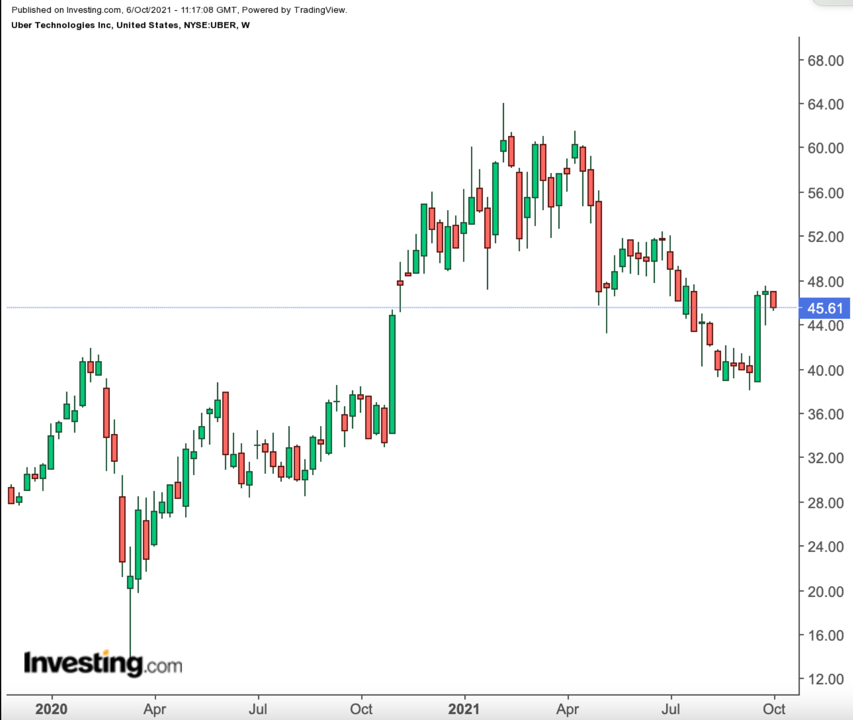
Uber’s business model faces an interesting challenge. When the supply of drivers is low relative to demand, Uber raises prices (what they call surge pricing) to incentivize drivers to be available. In theory, this should work fine, but the magnitude of price increases and longer wait times also motivates customers to choose other modes of transportation.
The company predicts that more drivers will join the platform and existing drivers will spend more time in service, to balance supply and demand, reducing surge pricing premiums. The market has not yet figured out how to set equilibrium prices. The hypothetical equilibrium prices for rides, such that riders find the service attractive and drivers are motivated to be available, depends on a range of factors.
Uber’s revenue stream comes from the fraction of fares that the company receives (referred to as the take rate) and, of course, Uber’s ability to generate earnings relies on growing the income from the company’s share. Uber’s take rate was 25.8% a year ago, but has declined to 18.7% as the company gives drivers more incentives.
At the time of writing, UBER is trading at $45.70, 27.7% below the YTD high closing price of $63.18, set on Feb.10.
Rather than trying to build my own projection for revenues and earnings, and then trying to calculate the fair price for the shares, I rely on two forms of consensus outlooks in analyzing a stock. The first is the well-known Wall Street analyst consensus outlook. The second is the market-implied outlook, a probabilistic expression of the consensus view from buyers and sellers of options on the stock.
The price of an option represents the market’s consensus estimate for the probability that the price of the stock will rise above (call option) or fall below (put option) a specific level (the strike price) between now and when the option expires. By analyzing calls and puts at a range of strike prices and a common expiration date, it is possible to calculate a probabilistic outlook for the underlying security that reconciles the options prices. This is the market-implied outlook. For those who are unfamiliar with the concept, I have written an overview post, including links to the relevant financial literature.
I last wrote about UBER on July 15. At that time, the Wall Street consensus was bullish, with a 12-month price target that was about 50% higher than the share price at that time. The market-implied outlook, by contrast, was quite bearish, with the peak probability corresponding to a price return of -14.9% to early 2022.
The expected volatility derived from the market-implied outlook was 45%. With the major disagreement between the options market and the analyst consensus, I compromised on a neutral rating. Since that post, UBER’s share price has moved -1.55% vs. -0.17 for the S&P 500.
After hitting a YTD low close of $38.48 on Sept. 15, the shares have gained 18.8%. The substantial gains in the past 3 weeks were triggered by optimistic company statements about Q3 and Q4. I am revisiting the comparison between the Wall Street consensus and the market-implied outlook in light of the company statements and the market response.
Wall Street Consensus Outlook for UBER
ETrade calculates the Wall Street consensus outlook using the views of 22 ranked analysts who have published ratings and price targets within the past 90 days. The consensus rating for UBER is bullish and the consensus 12-month price target is 49.6% above the current share price.
Of the 22 analysts, 21 give UBER a buy rating and 1 assigns a hold rating. One potential concern is the high level of dispersion among the analyst price targets, which reduces confidence in the meaningfulness of the consensus. While the lowest 12-month price target is 5% above the current price, indicating agreement among all of the analysts that the price is expected to rise, there is a wide range between the price targets.
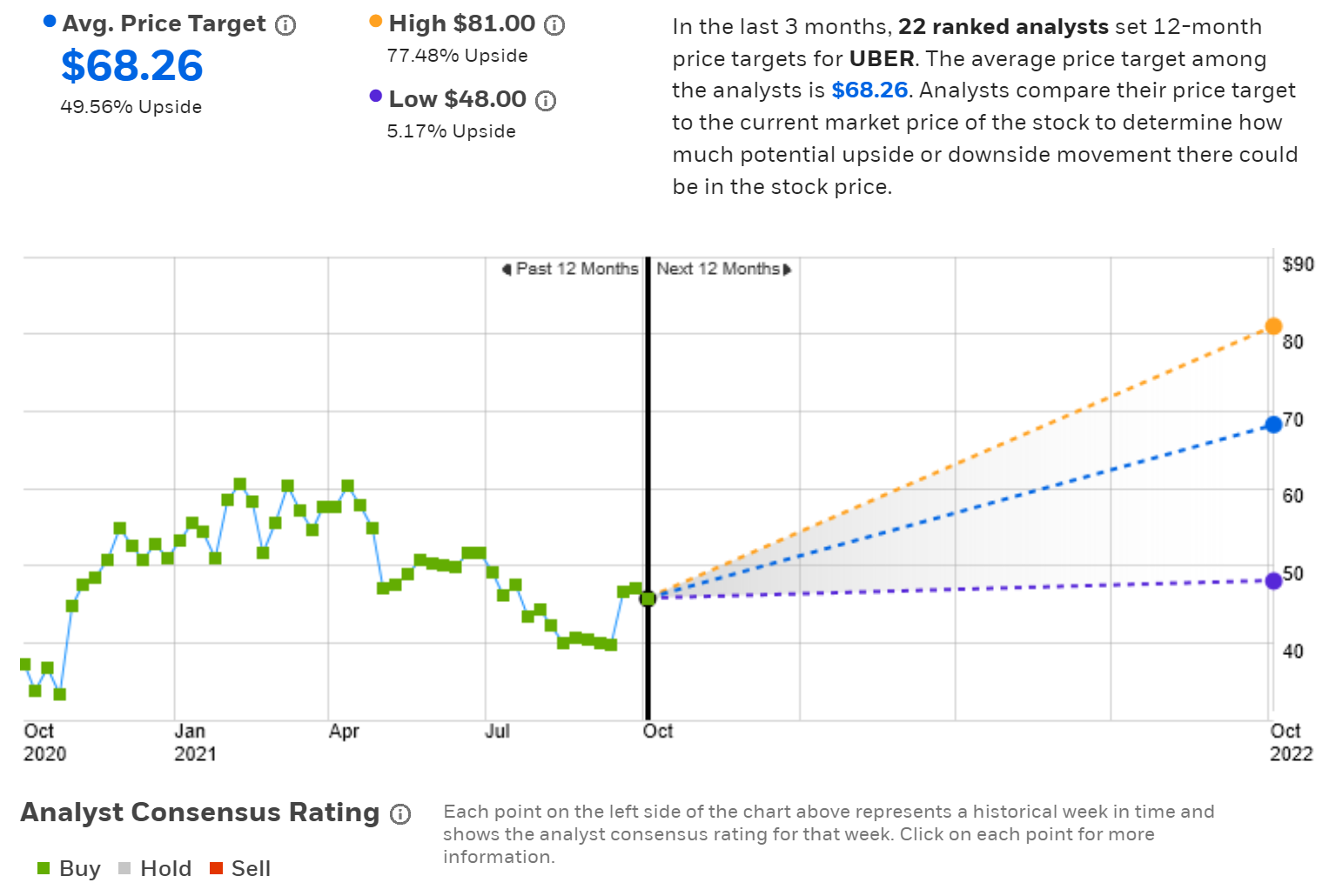
Source: ETrade
Investing.com calculates the Wall Street consensus outlook from the views of 45 analysts. The consensus rating is bullish and the consensus 12-month price target is 46.1% above the current share price. Only 1 analyst gives UBER a bearish rating.
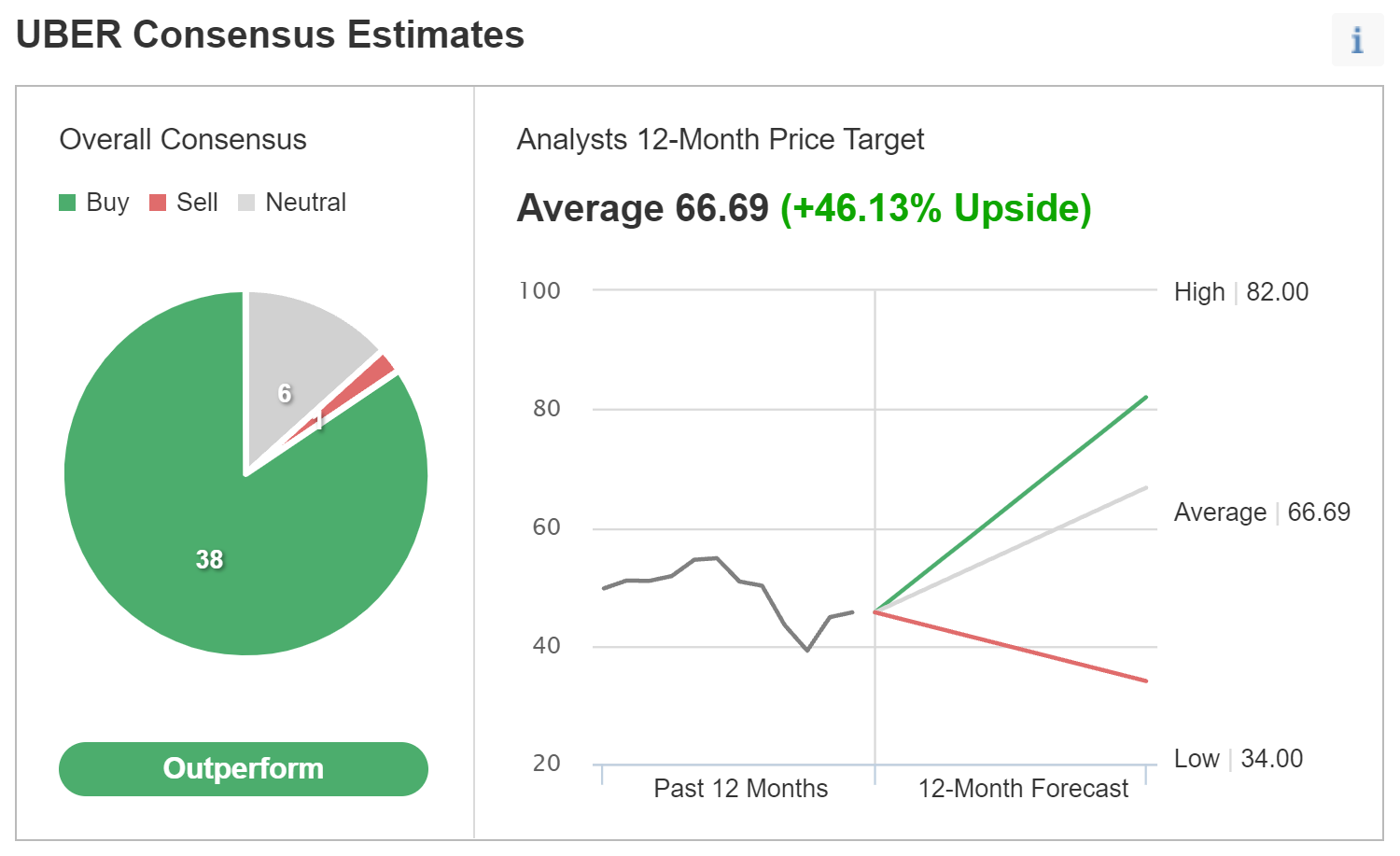
Source: Investing.com
The Wall Street consensus outlook for UBER continues to be very bullish, with expected 12-month gains in the range of 46%-50%. The Wall Street consensus has not changed substantially in response to UBER management’s recent commentary.
Market-Implied Outlook for UBER
I have analyzed call and put options on UBER at a range of strike prices, all expiring on Jan. 21, 2022, to generate the market-implied outlook for the next 3.5 months (from now until the expiration date). I have also generated the market-implied outlook for the next 8.3 months using options that expire on June 17, 2022. I selected these two expiration dates to give a view into early- and mid-2022, as well as because these expirations dates are especially actively traded.
The standard presentation of the market-implied outlook is in the form of a probability distribution of price return, with probability on the vertical axis and return on the horizontal.
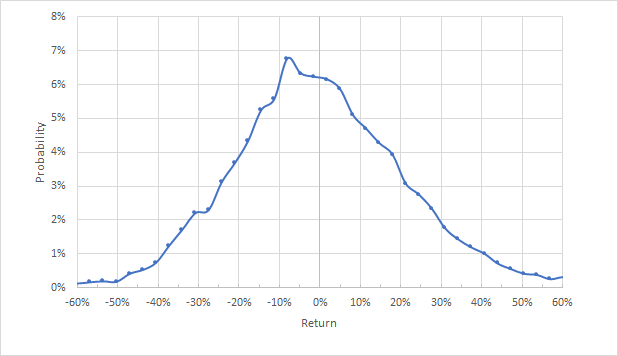
Source: Author’s calculations using options quotes from ETrade
While the market-implied outlook for UBER for the next 3.5 months is generally symmetric, the distribution is notably tilted towards negative returns. The peak probability corresponds to a price return of -8% for the next 3.5 months. The annualized volatility derived from this distribution is 45%. This is a high level of volatility. The estimated worst 1-in-5 outcomes (the 20th percentile) correspond to a price return of -18% or worse. The estimated 10th percentile outcome is a return of -27%.
To make it easier to directly compare the probabilities of positive and negative returns, I rotate the negative return side of the distribution about the vertical axis (see chart below).
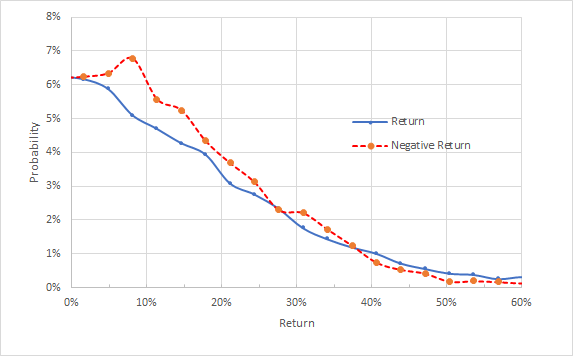
Source: Author’s calculations using options quotes from ETrade. The negative return side of the distribution has been rotated about the vertical axis.
This view shows that the probabilities of negative returns are consistently higher than for positive returns of the same magnitude for a wide range of the most-probable outcomes (the red dashed curve is at or above the solid blue curve for all but the least-probable returns). With the well-defined peak probability at a -8% return and the overall tilt toward negative returns, the market-implied outlook between now and Jan. 21, 2022 is bearish.
The market-implied outlook to mid-2022, calculated using options that expire on June 17, 2022, is also bearish. The peak probability corresponds to a price return of -20% for the next 8.3 months. The probabilities of negative returns are even more elevated relative to those for positive returns than in the outlook to mid January. The 8.3-month market-implied outlook has high positive skewness, a feature that is common with growth stocks. The most probable outcomes are negative but there is a small probability of a very large payout.
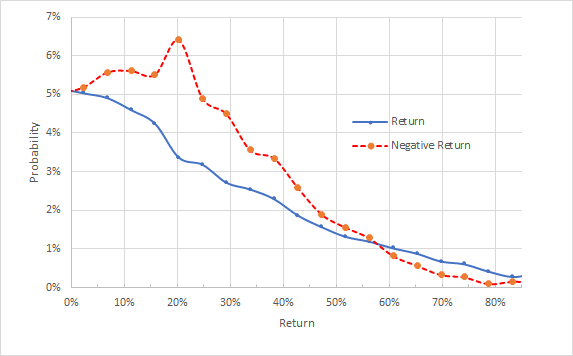
Source: Author’s calculations using options quotes from ETrade. The negative return side of the distribution has been rotated about the vertical axis.
The market-implied outlooks to January 2022 and June 2022 are bearish, with high volatility. In my previous analysis, the market-implied outlook to January 2022 was bearish. The updated outlook using Jan. 21, 2022 options remains bearish and the longer outlook is mid-2022 is also bearish.
Summary
Uber has had to deal with challenging market conditions since early 2020, when COVID-19 hobbled the economy. Figuring out how to balance customer needs with effective pay and incentives for drivers will be key to the firm’s progress towards profitability. The Wall Street analysts have been steadfastly bullish on UBER. The consensus 12-month price target is around 48% above the current share price.
The market-implied outlook, reflecting the consensus view of buyers and sellers of options, continues to be bearish, however, with high expected volatility. The Wall Street consensus and the market-implied outlook have changed little in recent months, even as the share price has risen 19% on management commentary. In light of the substantial disagreement between the analysts and the options market, I am maintaining a neutral rating on the stock.
